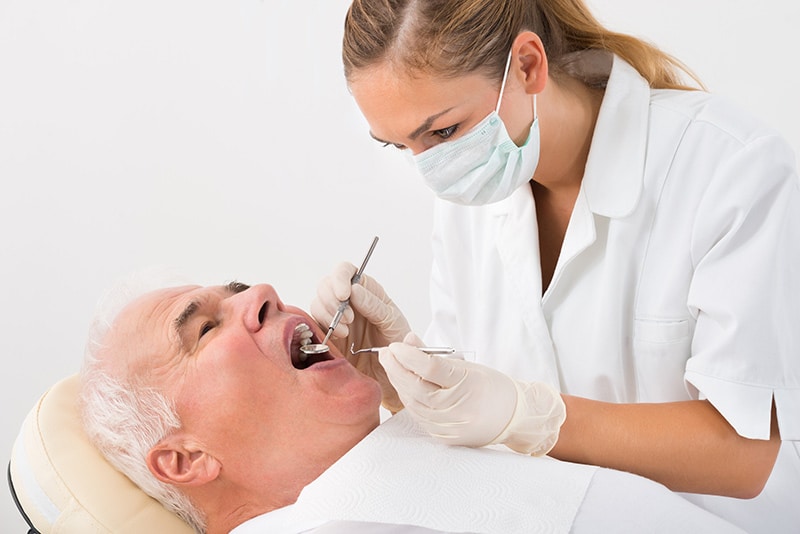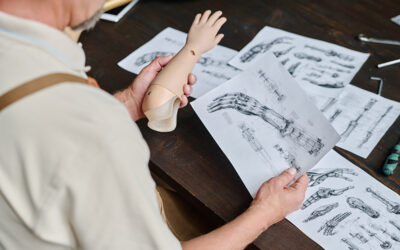Aging and related health problems can make the elderly population vulnerable to different types of dental issues. Maintaining good oral hygiene is difficult in older adults. Inadequate dental nutrition, poor dental care or eating habits, general wear and tear of teeth, usage of medications and other problems can cause severe oral health problems in older people. These issues can result in several symptoms like – gum infections, tooth pain, tooth decay, inflammation and bleeding in gums. Early identification of symptoms and other associated risk factors that lead to gum problems can help prevent these conditions in the long run. Insurance reimbursement for different types of dental conditions affecting elderly people can be challenging. Dental offices and dental billing companies must be up to date with the correct medical codes and payer guidelines to ensure accurate claim submission.
Here discussed are the top five common dental conditions affecting elderly people –
Receding Gums – Regarded as a common geriatric dental problem, receding gums occur when the gums recede or wear away, exposing the pink tissue that covers the root of the teeth. When gums recede, gaps can form between the gum and tooth, allowing disease-causing bacteria to build up. This condition occurs due to poor oral health, which may in turn lead to tooth loss. Age is one of the primary risk factors that lead to gum recession. It is estimated that about 88 percent of people above 65 years have a receding gum in at least one tooth. Several factors can cause the gums to recede and these include – periodontal or gum disease, poor oral hygiene, aggressive brushing over the long term, hardened plaque buildup (tartar), use of any tobacco product, diabetes, crooked teeth, bridges or partial dentures (that no longer fit), use of medications (that cause dry mouth) and certain immune disorders. In most cases, the condition does not display any specific symptoms at an early stage. As the condition progresses, patients may experience certain symptoms like – bad breath, loose and exposed tooth roots, bleeding after brushing or flossing, pain and swelling in gums and changing appearance of tooth. Diagnosis of this condition begins with a detailed physical examination to identify the key issues affecting the gums. Initial treatment modalities include a combination of medications and other procedures like – scaling and root planing and composite restoration. If the initial treatment modalities do not yield the desired results, surgical options like – flap surgery and grafting may be recommended. ICD-10 diagnosis codes for gum recession include –
- K06.0 Gingival recession
- K06.01 Gingival recession, localized
- K06.010 Localized gingival recession, unspecified
- K06.011 Localized gingival recession, minimal
- K06.012 Localized gingival recession, moderate
- K06.013 Localized gingival recession, severe
- K06.02 Gingival recession, generalized
- K06.020 Generalized gingival recession, unspecified
- K06.021 Generalized gingival recession, minimal
- K06.022 Generalized gingival recession, moderate
- K06.023 Generalized gingival recession, severe
Tooth Decay – Tooth decay can create cavity in the tooth – which permanently causes damages to the hard surface of teeth that develop into tiny openings or holes. Also called dental caries, the condition is caused by a combination of factors, including bacteria in the mouth; frequent snacking, sipping sugary drinks and not cleaning the teeth well. The signs and symptoms of this condition vary depending on the extent and location of cavities. When a cavity is just a beginning, the patient may not experience any specific signs and symptoms. However, as the decay worsens, it may cause symptoms like – toothache (spontaneous pain or pain that occurs without any apparent cause), tooth sensitivity (when eating or drinking something sweet, hot or cold), pain when biting, brown, black or white staining on any surface of a tooth and visible holes or pits in the teeth. If left untreated, tooth decay can cause pain, infection, and in extreme cases tooth loss. Treatment options include – fillings (also called restorations), tooth extraction, root canals, crowns and fluoride treatments. ICD – 10 codes include –
- K02 Dental caries
- K02.3 Arrested dental caries
- K02.5 Dental caries on pit and fissure surface
- K02.51 Dental caries on pit and fissure surface, limited to enamel
- K02.52 Dental caries on pit and fissure surface, penetrating into dentin
- K02.53 Dental caries on pit and fissure surface, penetrating into pulp
- K02.6 Dental caries on smooth surface
- K02.61 Dental caries on smooth surface, limited to enamel
- K02.62 Dental caries on smooth surface, penetrating into dentin
- K02.63 Dental caries on smooth surface, penetrating into pulp
- K02.7 Dental root caries
- K02.9 Dental caries, unspecified
Gum Disease – Also called periodontitis, this is a serious gum infection that damages the soft tissue and destroys the bone that supports the teeth. The dental condition occurs due to poor brushing and flossing habits that causes plaque (a sticky film of bacteria) to build up around the tooth. This may result in inflammation of the gums and cause redness, swelling and a tendency to bleed during brushing. It can also cause the teeth to loosen or lead to tooth loss. Common symptoms include – swollen gums, pus between the teeth and gums, bad breath, bleeding gums, painful chewing and a metallic taste in the mouth. As the condition is usually the result of poor hygiene, maintaining good oral habits like – brushing at least twice a day, flossing daily and getting regular dental checkups – can help keep the teeth and gums healthy, prevent infection in the long run thereby greatly improving your chances of successful treatment.
- K05 Gingivitis and periodontal diseases
- K05.2 Aggressive periodontitis
- K05.3 Chronic periodontitis
- K05.4 Periodontosis
- K05.5 Other periodontal diseases
- K05.6 Periodontal disease, unspecified
Dry Mouth – Also known as xerostomia, dry mouth refers to a condition wherein the salivary glands in the mouth don’t make enough saliva to keep the mouth wet. In most cases, the condition is due to aging issues that directly affect the salivary glands. It can also occur as the side effect of certain medications, radiation therapy for cancer, nerve damage, recreational drug use, tobacco/alcohol use and other health conditions. Signs and symptoms include – thick and stringy saliva, dryness or a feeling of stickiness in the mouth, dry or sore throat and hoarseness, bad breath, difficulty in chewing, speaking and swallowing and dry or grooved tongue. Treatment includes medications to moisturize mouth, to stimulate saliva and protect the teeth. ICD – code for dry mouth include –
- R68.2 Dry mouth, unspecified
Oral Cancer – A common condition among older adults, oral or mouth cancer occurs in the tissues of the mouth (known as the oral cavity) or the throat area at the back of the mouth, the oropharynx. Reports from the Oral Cancer Foundation (OCF) suggest that in 2021 about 54,000 people in the US will be newly diagnosed with oral cancer. The condition is more likely to affect males than females, with the average age of diagnosis being 62 years. The condition does not depict any specific signs and symptoms in its early stages. The type and severity of symptoms may depend and vary from person to person. Common symptoms include – mouth sores or ulcers, red or white patches in or behind the mouth, visible change in mouth tissue, unexplained swelling or fullness in neck, loose teeth, difficult or painful swallowing, and pain and tenderness in the teeth or gums. Oral cancers develop when cells on the lips or in the mouth develop changes (mutations) in their DNA and start growing without control. As these continue to grow and accumulate, they form a tumor. Diagnosis of oral cancer will begin with an examination of the lips and mouth to check for abnormalities like – areas of irritation, such as sores and white patches (leukoplakia). If any suspicious area is diagnosed, sample cells may be collected for lab testing. The sample cells are analyzed for cancer or precancerous changes that indicate a risk of future cancer. ICD-10 codes include –
- C00 Malignant neoplasm of lip
- C01 Malignant neoplasm of base of tongue
- C02 Malignant neoplasm of other and unspecified parts of tongue
- C03 Malignant neoplasm of gum
- C04 Malignant neoplasm of floor of mouth
- C05 Malignant neoplasm of palate
- C06 Malignant neoplasm of other and unspecified parts of mouth
- C07 Malignant neoplasm of parotid gland
- C08 Malignant neoplasm of other and unspecified major salivary glands
- C09 Malignant neoplasm of tonsil
- C10 Malignant neoplasm of oropharynx
- C11 Malignant neoplasm of nasopharynx
- C12 Malignant neoplasm of pyriform sinus
- C13 Malignant neoplasm of hypopharynx
- C14 Malignant neoplasm of other and ill-defined sites in the lip, oral cavity and pharynx
Incorporating good dental habits can help reduce the damages occurring to the mouth lining in the long run. Brushing the teeth twice daily with fluoride toothpaste, flossing the teeth every day and undergoing regular and professional dental cleanings can help prevent the occurrence of dental problems. Other prevention strategies include – stopping smoking, chewing tobacco and the consumption of alcohol, eating antioxidant-rich foods, avoiding abrasive dental hygiene products (like whiteners and rinses), and attending routine dental exams.
Medical billing and coding for dental disorders can be complex. Relying on dental billing services offered by reputable providers that offer the services of AAPC-certified coding specialists can help in accurate and timely billing and claims submission.




